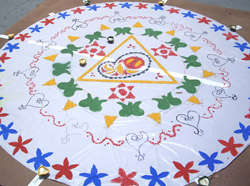Rangoli - An Indian Custom of Welcome
By Laura Westbrook
Rangoli are pictorial or geometric designs made of colored powders or ground chalk, sometimes paint, and usually incorporating natural materials such as colored rice, turmeric, ground chili, dried dal (lentils), or flowers. The designs are usually circular and may incorporate numerous images, and they are created out of doors near the entrance to a home. This ancient decorative art is practiced by women across India, and immigrants to Louisiana maintain the tradition. Its beauty, and the meticulous work required to produce one, make it a highly-regarded symbol of hospitality. The ephemeral aspect of the rangoli-it may last only one day, or it may be replaced each day during a holiday season-makes it all the more valued for the work involved, as a symbol of respect for an occasion, and as a reminder of the fleeting nature of time.

Madhu Gilotra first became interested in this traditional Indian craft as a child in New Delhi, watching female relatives, neighbors and friends make rangoli at their houses and at the temples. Her parents celebrated traditional holidays but, says Madhu, "they let some of the finer points go because there were nine of us kids. But we celebrated the holidays and made the traditional dishes, and my family does these things now." The extended family "did the rangoli for weddings and holidays, especially for Diwali, the Festival of Lights, and I have always loved the art that goes into them." Mrs. Gilotra moved from New Delhi to New Orleans as a young bride with her husband Darshan, and is a professional nurse with a strong life-long interest in design. Her 3 children are now young adults and all are active, to varying degrees in the Indian Association of New Orleans (IANO). Mahdu finds that, though her artistic interests are wide-ranging, her own work is strongly influenced by colors and motifs from home. She creates her rangoli patterns by drawing them freehand. When asked how she develops her ideas, she says,
I see things that inspire me all throughout my day—they might be a henna tattoo design or just a picture, and I can see how different elements would blend together to create a whole design. My designs may not be strictly traditional, but they are artistic and they reflect my sense of design. If the weather is breezy, I sometimes use paint for the outer parts of the design, to keep it together, and use powders and rice for the inside.
Madhu says that each of her rangoli incorporates both traditional images (such as florals or paisleys) and newly-created patterns (such as geometric motifs). She also exercises her skill in interior design through flower arrangement, by decorating homes for Diwali celebrations or for a special puja. She makes the arrangements and decorates for special events held by the Indian Association of New Orleans. And she paints elephants.
According to IANO president Jayant Jani, Diwali is the most widely-celebrated of the Asian Indian celebrations in Louisiana. It is observed all over India, and by Indian communities around the world. The most important day is reserved for prayer, but the entire event, which falls in October or November, spans 4-5 days and is also known as the Festival of Light. Dr. Jani says, "People light up their homes for Diwali gatherings with holiday lights and candles. Some people set off fireworks as part of the festivities. This is a happy time and a family time; people gather together to feast and to exchange gifts." During the festival of Diwali, the Goddess Lakshmi (or Laxmi) is said to visit the homes of people who set out a proper welcome-with bright lights and festive decorations-bringing good fortune for the coming year. Sometimes small footprints from the walkway to the front door, representing the footprints of the diety, are incorporated into the overall design. Jayant points out that "The rangoli is auspicious as an invitation to the goddess and also as a way to honor and welcome all visitors to the home. The rangoli also is created for important family occasions such as weddings for much the same reason, to attract beauty and luck into the lives of the new couple."
From the time a design-plan is drawn on paper, says Madhu, it takes about 2 or 3 hours to create a rangoli. She maintains the tradition of having a central image at the center of a mostly-round design (the circle can represent the endless nature of time, the circle of life, paths of celestial bodies, or all of these). She begins at the center and works outward, which allows her to maintain symmetry within the overall pattern. Asked how she knows when a piece is completed, she says, "It is never finished! But you have to stop somewhere. I begin in the center, and if there's time I can add to the edges and fill in there. Really, the picture itself will tell you."
Madhu's work is valued by her community, but she says she will never regard herself as a master of the form. "There are artists, especially in the rural parts of India, who have been doing this holy art form for generations and they are important in their communities because of their skill. I pick up things and hope to make something beautiful, but they rely on their skills for their living. I do nursing for my living, but art is my passion."
And the elephant painting? Madhu learned how to do that much more recently. "I didn't learn from anyone else but just relied on what I had seen in the past. Raj [Rajender] Pannu wanted somebody to do this a few years ago for the [Asian Heritage] festival like they do for festivals in southern India. She was looking for someone who could try it and I said, "Okay, I'll do it."
Her main concern, she says, was for the elephants. Her only reluctance concerned which paints would be appropriate, so Audubon Zoo staff (the festival is held at the Audubon Zoo each spring) got into the act as well. "I told them, 'You provide the paint and I'll do it.'" They researched non-toxic paints that would be fine for the animals and provided them to Madhu. Her second concern was her own safety and the logistics of painting the huge animals. "This was not a problem at all. The trainers were right there, and they told the elephants, 'Sit down; stand up; bend your head.' The elephants were so smart. They understood and did everything they were asked."
Madhu has done this several times now and has come to enjoy and respect the elephants, and even feel that she knows them a bit. The reaction of the children is a favorite aspect of the process. "I can hear the children while I do the painting. They are saying, 'Oh, the colors are so pretty!,' 'She is making the elephants so beautiful!' I can't turn around because I still don't want to go under the elephant's foot, but I love to hear their comments. I do love the whole experience and would do it again. "
Madhu says, "I love working with rangoli. Even painting the elephants is a way to express artistic creativity. When I get the chance to do this, and also take part in continuing and sharing my culture, that is the best."
The Smithsonian Institution defines puja as "the act of showing reverence to a god or to aspects of the divine through invocations, prayers, songs, and rituals. An essential part of puja for the Hindu devotee is making a spiritual connection with a deity. Most often that contact is facilitated through an object: an element of nature, a sculpture, a vessel, a painting, or a print."



